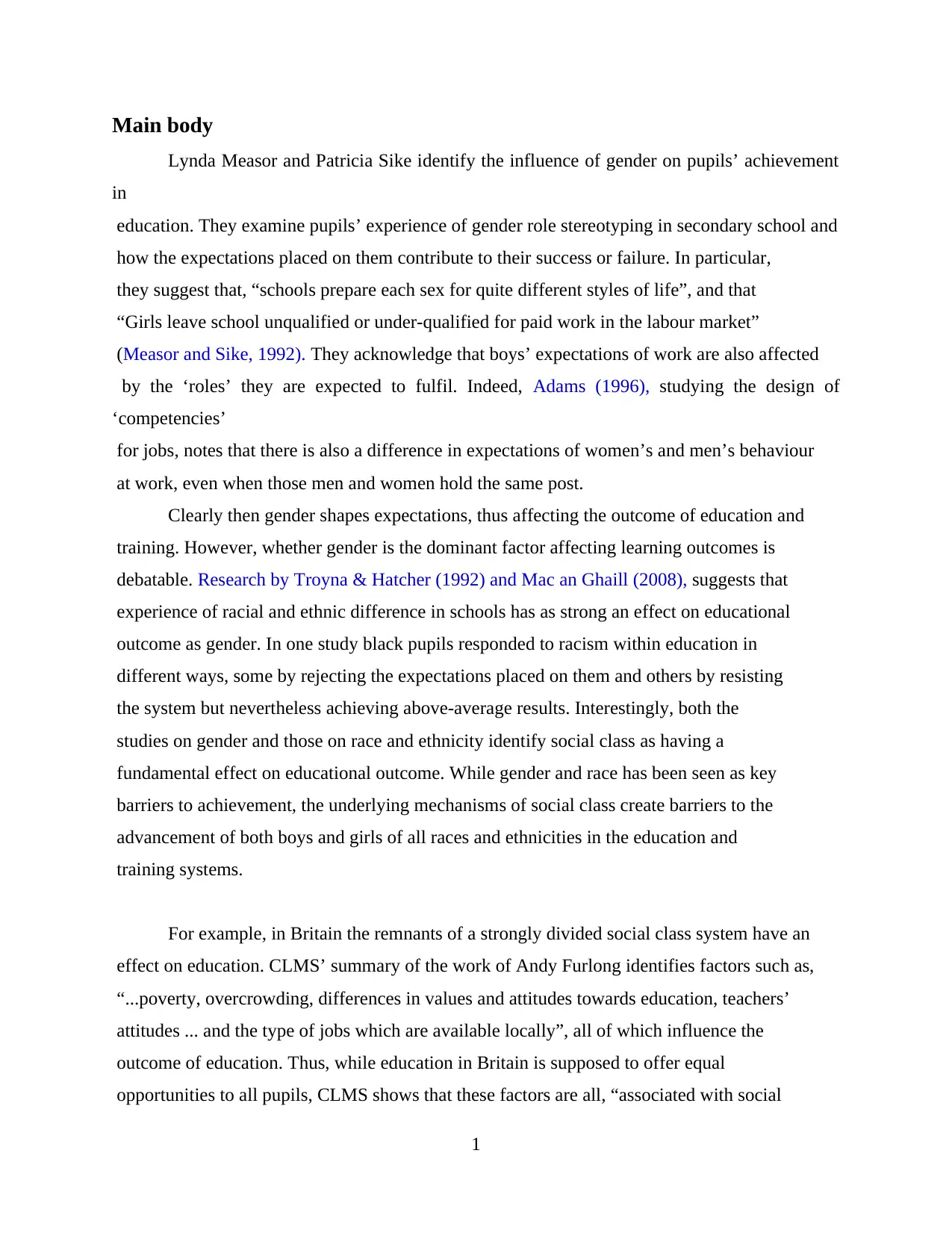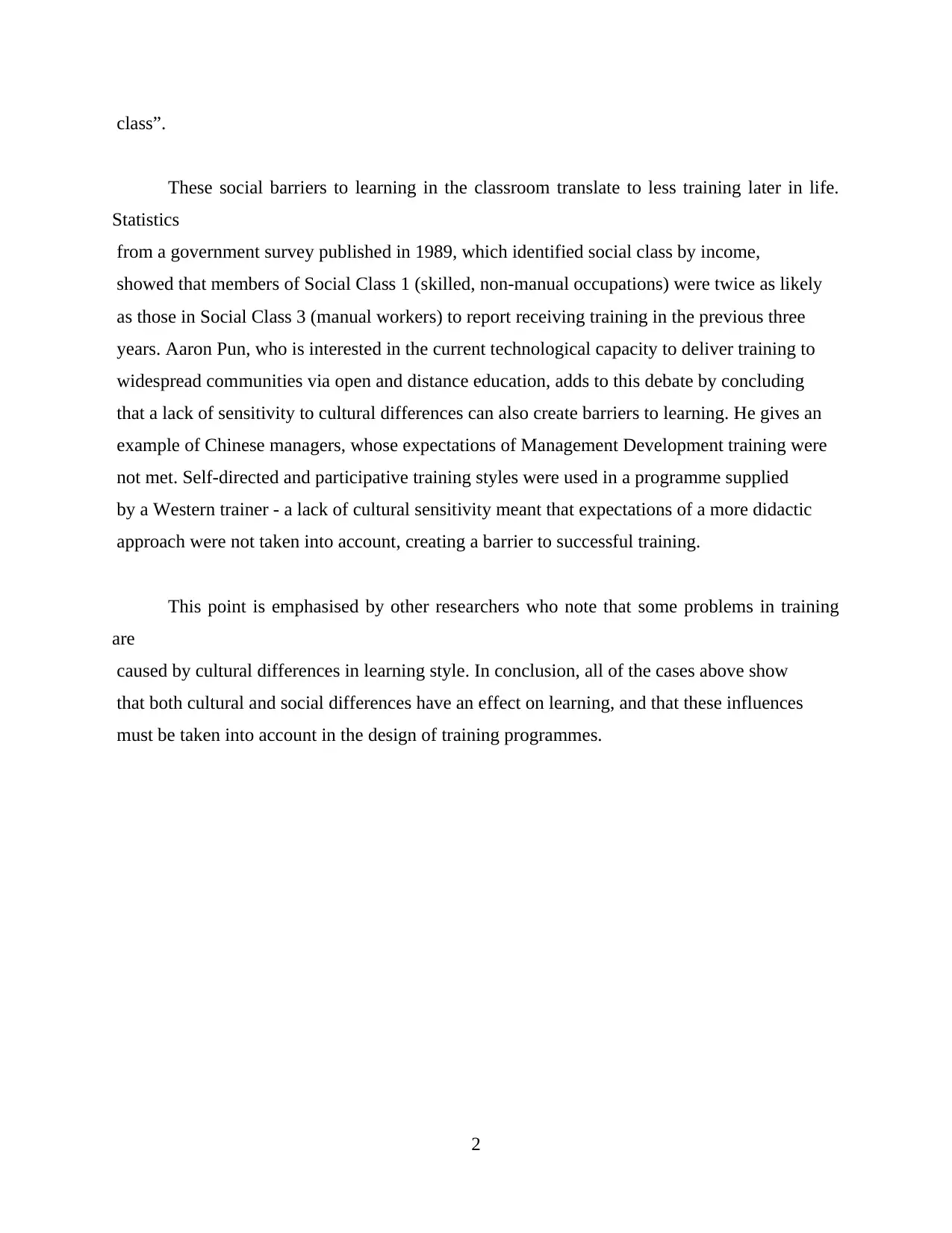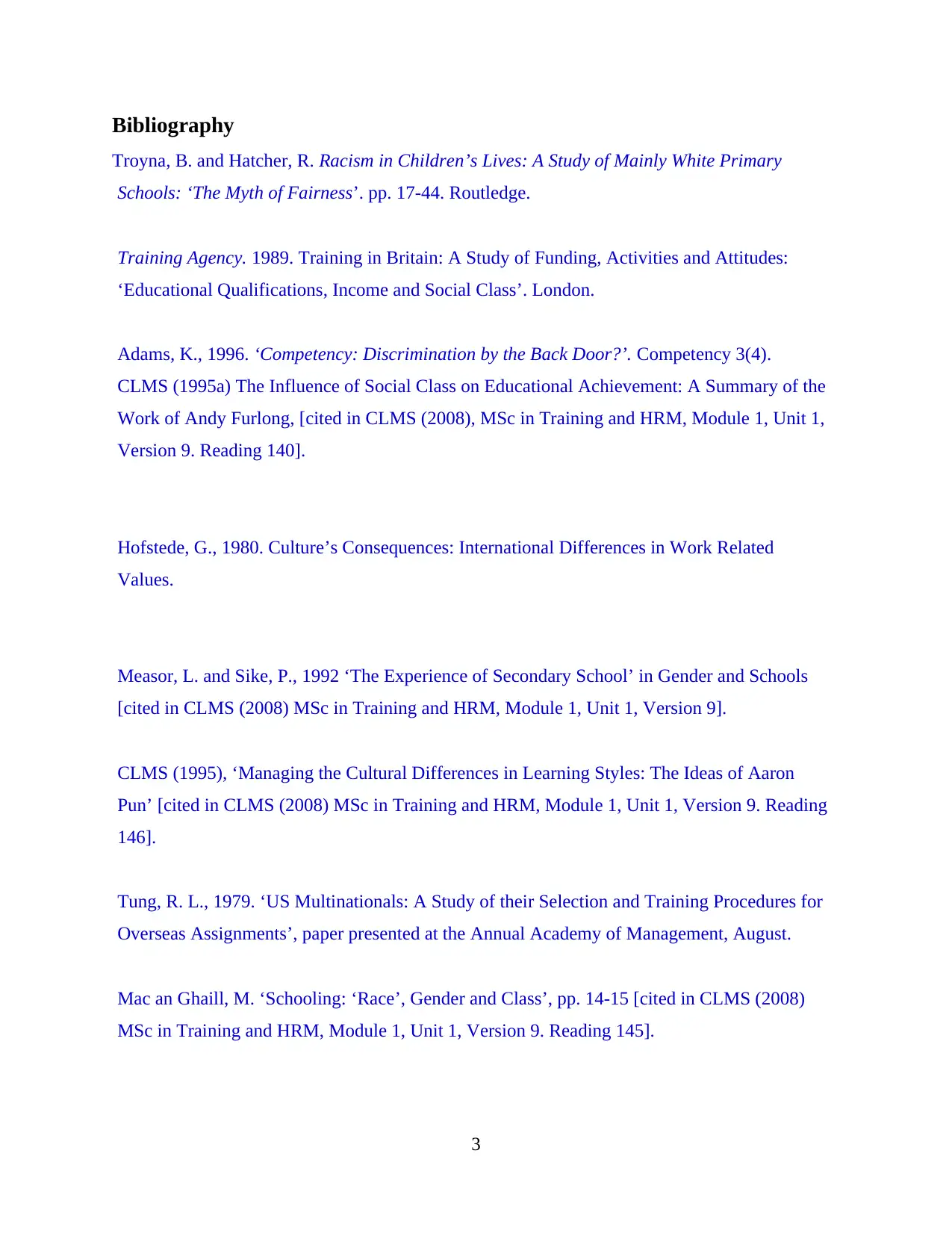Analyzing Factors Influencing Learning in Training Programs
VerifiedAdded on 2019/12/18
|6
|998
|338
Report
AI Summary
This report examines the multifaceted factors influencing learning outcomes, encompassing gender, race, and social class as primary determinants. It explores the impact of gender role stereotyping, as highlighted by Measor and Sike, and how societal expectations shape educational success. The report also delves into the effects of racial and ethnic differences, drawing on research by Troyna & Hatcher and Mac an Ghaill, which reveals that social class creates significant barriers to advancement, as emphasized by CLMS's summary of Furlong's work. Furthermore, the report considers the role of cultural differences, as illustrated by Pun's observations on training program effectiveness. The findings underscore the need to acknowledge and address these diverse influences when designing and implementing training programs to foster equitable learning environments.

Portfolio
Paraphrase This Document
Need a fresh take? Get an instant paraphrase of this document with our AI Paraphraser

Table of Contents
Main body........................................................................................................................................1
Bibliography
..........................................................................................................................................................3
Main body........................................................................................................................................1
Bibliography
..........................................................................................................................................................3

Main body
Lynda Measor and Patricia Sike identify the influence of gender on pupils’ achievement
in
education. They examine pupils’ experience of gender role stereotyping in secondary school and
how the expectations placed on them contribute to their success or failure. In particular,
they suggest that, “schools prepare each sex for quite different styles of life”, and that
“Girls leave school unqualified or under-qualified for paid work in the labour market”
(Measor and Sike, 1992). They acknowledge that boys’ expectations of work are also affected
by the ‘roles’ they are expected to fulfil. Indeed, Adams (1996), studying the design of
‘competencies’
for jobs, notes that there is also a difference in expectations of women’s and men’s behaviour
at work, even when those men and women hold the same post.
Clearly then gender shapes expectations, thus affecting the outcome of education and
training. However, whether gender is the dominant factor affecting learning outcomes is
debatable. Research by Troyna & Hatcher (1992) and Mac an Ghaill (2008), suggests that
experience of racial and ethnic difference in schools has as strong an effect on educational
outcome as gender. In one study black pupils responded to racism within education in
different ways, some by rejecting the expectations placed on them and others by resisting
the system but nevertheless achieving above-average results. Interestingly, both the
studies on gender and those on race and ethnicity identify social class as having a
fundamental effect on educational outcome. While gender and race has been seen as key
barriers to achievement, the underlying mechanisms of social class create barriers to the
advancement of both boys and girls of all races and ethnicities in the education and
training systems.
For example, in Britain the remnants of a strongly divided social class system have an
effect on education. CLMS’ summary of the work of Andy Furlong identifies factors such as,
“...poverty, overcrowding, differences in values and attitudes towards education, teachers’
attitudes ... and the type of jobs which are available locally”, all of which influence the
outcome of education. Thus, while education in Britain is supposed to offer equal
opportunities to all pupils, CLMS shows that these factors are all, “associated with social
1
Lynda Measor and Patricia Sike identify the influence of gender on pupils’ achievement
in
education. They examine pupils’ experience of gender role stereotyping in secondary school and
how the expectations placed on them contribute to their success or failure. In particular,
they suggest that, “schools prepare each sex for quite different styles of life”, and that
“Girls leave school unqualified or under-qualified for paid work in the labour market”
(Measor and Sike, 1992). They acknowledge that boys’ expectations of work are also affected
by the ‘roles’ they are expected to fulfil. Indeed, Adams (1996), studying the design of
‘competencies’
for jobs, notes that there is also a difference in expectations of women’s and men’s behaviour
at work, even when those men and women hold the same post.
Clearly then gender shapes expectations, thus affecting the outcome of education and
training. However, whether gender is the dominant factor affecting learning outcomes is
debatable. Research by Troyna & Hatcher (1992) and Mac an Ghaill (2008), suggests that
experience of racial and ethnic difference in schools has as strong an effect on educational
outcome as gender. In one study black pupils responded to racism within education in
different ways, some by rejecting the expectations placed on them and others by resisting
the system but nevertheless achieving above-average results. Interestingly, both the
studies on gender and those on race and ethnicity identify social class as having a
fundamental effect on educational outcome. While gender and race has been seen as key
barriers to achievement, the underlying mechanisms of social class create barriers to the
advancement of both boys and girls of all races and ethnicities in the education and
training systems.
For example, in Britain the remnants of a strongly divided social class system have an
effect on education. CLMS’ summary of the work of Andy Furlong identifies factors such as,
“...poverty, overcrowding, differences in values and attitudes towards education, teachers’
attitudes ... and the type of jobs which are available locally”, all of which influence the
outcome of education. Thus, while education in Britain is supposed to offer equal
opportunities to all pupils, CLMS shows that these factors are all, “associated with social
1
⊘ This is a preview!⊘
Do you want full access?
Subscribe today to unlock all pages.

Trusted by 1+ million students worldwide

class”.
These social barriers to learning in the classroom translate to less training later in life.
Statistics
from a government survey published in 1989, which identified social class by income,
showed that members of Social Class 1 (skilled, non-manual occupations) were twice as likely
as those in Social Class 3 (manual workers) to report receiving training in the previous three
years. Aaron Pun, who is interested in the current technological capacity to deliver training to
widespread communities via open and distance education, adds to this debate by concluding
that a lack of sensitivity to cultural differences can also create barriers to learning. He gives an
example of Chinese managers, whose expectations of Management Development training were
not met. Self-directed and participative training styles were used in a programme supplied
by a Western trainer - a lack of cultural sensitivity meant that expectations of a more didactic
approach were not taken into account, creating a barrier to successful training.
This point is emphasised by other researchers who note that some problems in training
are
caused by cultural differences in learning style. In conclusion, all of the cases above show
that both cultural and social differences have an effect on learning, and that these influences
must be taken into account in the design of training programmes.
2
These social barriers to learning in the classroom translate to less training later in life.
Statistics
from a government survey published in 1989, which identified social class by income,
showed that members of Social Class 1 (skilled, non-manual occupations) were twice as likely
as those in Social Class 3 (manual workers) to report receiving training in the previous three
years. Aaron Pun, who is interested in the current technological capacity to deliver training to
widespread communities via open and distance education, adds to this debate by concluding
that a lack of sensitivity to cultural differences can also create barriers to learning. He gives an
example of Chinese managers, whose expectations of Management Development training were
not met. Self-directed and participative training styles were used in a programme supplied
by a Western trainer - a lack of cultural sensitivity meant that expectations of a more didactic
approach were not taken into account, creating a barrier to successful training.
This point is emphasised by other researchers who note that some problems in training
are
caused by cultural differences in learning style. In conclusion, all of the cases above show
that both cultural and social differences have an effect on learning, and that these influences
must be taken into account in the design of training programmes.
2
Paraphrase This Document
Need a fresh take? Get an instant paraphrase of this document with our AI Paraphraser

Bibliography
Troyna, B. and Hatcher, R. Racism in Children’s Lives: A Study of Mainly White Primary
Schools: ‘The Myth of Fairness’. pp. 17-44. Routledge.
Training Agency. 1989. Training in Britain: A Study of Funding, Activities and Attitudes:
‘Educational Qualifications, Income and Social Class’. London.
Adams, K., 1996. ‘Competency: Discrimination by the Back Door?’. Competency 3(4).
CLMS (1995a) The Influence of Social Class on Educational Achievement: A Summary of the
Work of Andy Furlong, [cited in CLMS (2008), MSc in Training and HRM, Module 1, Unit 1,
Version 9. Reading 140].
Hofstede, G., 1980. Culture’s Consequences: International Differences in Work Related
Values.
Measor, L. and Sike, P., 1992 ‘The Experience of Secondary School’ in Gender and Schools
[cited in CLMS (2008) MSc in Training and HRM, Module 1, Unit 1, Version 9].
CLMS (1995), ‘Managing the Cultural Differences in Learning Styles: The Ideas of Aaron
Pun’ [cited in CLMS (2008) MSc in Training and HRM, Module 1, Unit 1, Version 9. Reading
146].
Tung, R. L., 1979. ‘US Multinationals: A Study of their Selection and Training Procedures for
Overseas Assignments’, paper presented at the Annual Academy of Management, August.
Mac an Ghaill, M. ‘Schooling: ‘Race’, Gender and Class’, pp. 14-15 [cited in CLMS (2008)
MSc in Training and HRM, Module 1, Unit 1, Version 9. Reading 145].
3
Troyna, B. and Hatcher, R. Racism in Children’s Lives: A Study of Mainly White Primary
Schools: ‘The Myth of Fairness’. pp. 17-44. Routledge.
Training Agency. 1989. Training in Britain: A Study of Funding, Activities and Attitudes:
‘Educational Qualifications, Income and Social Class’. London.
Adams, K., 1996. ‘Competency: Discrimination by the Back Door?’. Competency 3(4).
CLMS (1995a) The Influence of Social Class on Educational Achievement: A Summary of the
Work of Andy Furlong, [cited in CLMS (2008), MSc in Training and HRM, Module 1, Unit 1,
Version 9. Reading 140].
Hofstede, G., 1980. Culture’s Consequences: International Differences in Work Related
Values.
Measor, L. and Sike, P., 1992 ‘The Experience of Secondary School’ in Gender and Schools
[cited in CLMS (2008) MSc in Training and HRM, Module 1, Unit 1, Version 9].
CLMS (1995), ‘Managing the Cultural Differences in Learning Styles: The Ideas of Aaron
Pun’ [cited in CLMS (2008) MSc in Training and HRM, Module 1, Unit 1, Version 9. Reading
146].
Tung, R. L., 1979. ‘US Multinationals: A Study of their Selection and Training Procedures for
Overseas Assignments’, paper presented at the Annual Academy of Management, August.
Mac an Ghaill, M. ‘Schooling: ‘Race’, Gender and Class’, pp. 14-15 [cited in CLMS (2008)
MSc in Training and HRM, Module 1, Unit 1, Version 9. Reading 145].
3

4
⊘ This is a preview!⊘
Do you want full access?
Subscribe today to unlock all pages.

Trusted by 1+ million students worldwide
1 out of 6
Related Documents
Your All-in-One AI-Powered Toolkit for Academic Success.
+13062052269
info@desklib.com
Available 24*7 on WhatsApp / Email
![[object Object]](/_next/static/media/star-bottom.7253800d.svg)
Unlock your academic potential
Copyright © 2020–2025 A2Z Services. All Rights Reserved. Developed and managed by ZUCOL.





